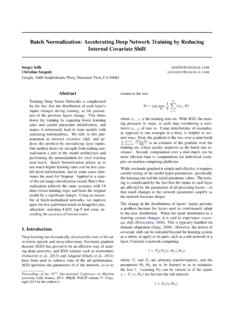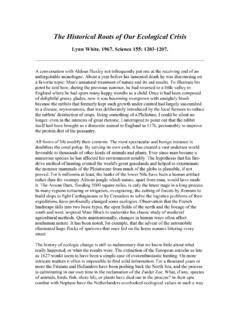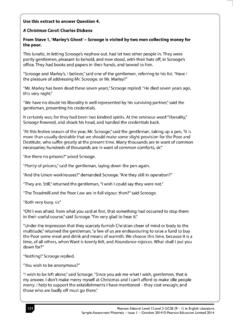Transcription of Social norms and social influence - Columbia University
1 Social norms and Social influenceRachel I McDonald and christian S CrandallPsychology has a long history of demonstrating the power andreach of Social norms ; they can hardly be overestimated. Todemonstrate their enduring influence on a broad range of socialphenomena, we describe two fields where research continuesto highlight the power of Social norms : prejudice and energyuse. The prejudices that people report map almost perfectlyonto what is socially appropriate, likewise, people adjust theirenergy use to be more in line with their neighbors. We reviewnew approaches examining the effects of norms stemmingfrom multiple groups, and utilizing normative referents to shiftbehaviors in Social networks.
2 Though the focus of less researchin recent years, our review highlights the fundamental influenceof Social norms on Social of Psychology, University of Kansas, Lawrence, KS 66045,USAC orresponding author: Crandall, christian S Opinion in Behavioral Sciences 2015, 3:147 151 This review comes from a themed issue on Social behaviorEdited by Molly J Crockett and Amy CuddyFor a complete overview see the Issue and the EditorialAvailable online 21st April 2015 # 2015 Elsevier Ltd. All rights most central, useful, powerful set of Social psycho-logical ideas is the triumvirate of imitation, conformity,and Social norms .
3 Social norms are the foundation ofculture, of language, of Social interaction, cuisine, love,marriage, play, prejudice, economic exchange and trafficcontrol. The elements of this list are fundamental tohuman life; the list is human organism is built for Social norms . Thefoundations of Social norms in imitation and Social learn-ing are common to all primates [1], and are especiallydeveloped in humans [2 ]. Well-developed brain struc-tures support awareness of others ( , facial recognition[3]; mirror neurons [4]), and human language capacity [5]are fundamental to Social other primates, humans pay careful attention toothers [6], and they imitate what they see [7].
4 Butknowledge of others actions (or beliefs, emotions, values)and their imitation is not enough to implicate socialnorms. Imitation is common enough in many forms oflife what creates the foundation for culture and societyis not the imitation, but the expectation of others for whenimitation is appropriate, and when it is Social norm is an expectation about appropriate behav-ior that occurs in a group context. Sherif and Sherif [8] saythat Social norms are formed in group situations andsubsequently serve as standards for the individual s per-ception and judgment when he [sic] is not in the groupsituation.
5 The individual s major Social attitudes areformed in relation to group norms (pp. 202 203). Socialnorms, or group norms , are regularities in attitudes andbehavior that characterize a Social group and differentiateit from other Social groups [9 ] (p. 7).What do norms do? norms not only detail what is appropriate behavior, butthese expectations in turn define what the group does,and who the group is. Identity is formed by group norms ,and by conforming to them. Deviation from Social normsleads first to communication designed to engender con-formity [10 ], and if Social expectations are not met and ifthe Social norm is important, deviation leads to loss ofsocial status or exclusion [11 ].
6 Are there different kinds of norms ?Many psychologists have differentiated among norms andthe role they play in Social influence . One durable dis-tinction is between norms that simply describe whatpeople in a group do, and norms that describe what peoplein a group should do [12]. Cialdini et al. [13 ] characterizedescriptive norms as the norms of what is, a sort ofinformational summary of how a group behaves, andinjunctive norms as the perception of what most peopleapprove or disapprove (or the norms of ought) [13 ](p. 203).Different kinds of norms are thought to determine dif-ferent kinds of influence .
7 Descriptive, informationalnorms lead to influence through education and conver-sion the process of conforming to descriptive normshas been called informational Social influence , and theattitudes that form, or behavior that results from this kindof influence is seen as genuine and unstrained. Whennorms are about what a group considers appropriate,moral, or necessary injunctive norms the processof conforming has been called normative group pressure, and the attitudes that form, or behavior that results fromthis kind of influence is seen as managed, ambivalent, lessgenuine, and often conflicted [14 ].
8 Available online at Current Opinion in Behavioral Sciences 2015, 3:147 151 Recent research provides compelling evidence for theexistence of distinct forms of normative influence . Jacob-son et al. [15 ] demonstrated that injunctive norms areassociated with more interpersonally oriented self-aware-ness and greater conflict about conformity findings show that exhaustion or depletion leadsto decreased conformity to injunctive norm informationbut increased conformity to descriptive norms . Differentmotivations underlie conformity to descriptive and in-junctive norms .
9 In a similar vein, Melnyk and colleagues[16] showed descriptive norms had greater influenceunder promotion than prevention focus, whereas injunc-tive norm influence was unaffected by regulatory focus;the psychological underpinnings of conformity differaccording to the type of normative influence is fundamental and pervasive; a com-plete review of their reach or the research would illustrate theimportance of socialnorms, wenext examine some recent advances in Social norm researchin two markedly different Social domains: prejudice andenergy conservation.
10 A review of these quite distinct issuesunderscores the breadth of influence of Social norms onsocial life, cognition, and behavior (Figure 1).Prejudice: From the earliest research, Social norms havebeen pointed to as a cause of prejudice, about half of allprejudiced attitudes are based only on the need to con-form [17] (p. 286). The norms approach emerged as analternative to personality approaches [18], and researchshows very high levels of conformity to norms in theprejudice domain [19 ]. The presence of an audience (anormative cue) leads to more normative behavior ( ,suppressed discrimination [20 ]); this attentiveness tonorms develops around 8 10 years of age [21].

















